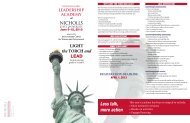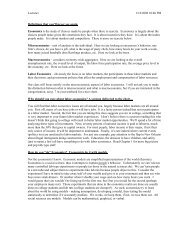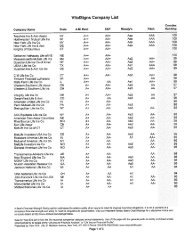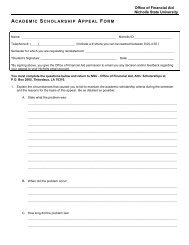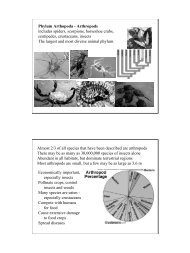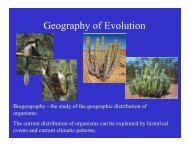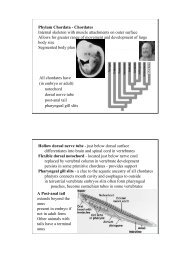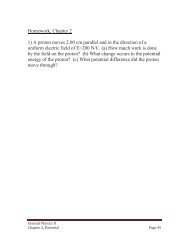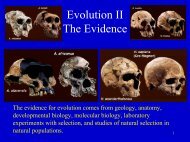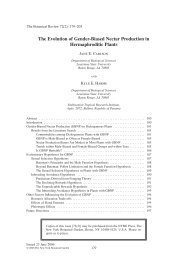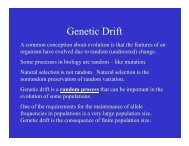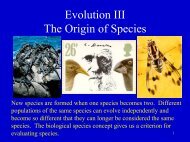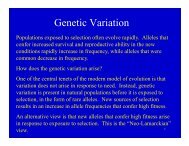Coelomates: Protostomes and Deuterostomes Protostomes have ...
Coelomates: Protostomes and Deuterostomes Protostomes have ...
Coelomates: Protostomes and Deuterostomes Protostomes have ...
Create successful ePaper yourself
Turn your PDF publications into a flip-book with our unique Google optimized e-Paper software.
Phylum Echinodermata - Echinodermsincludes starfish, sea urchins,s<strong>and</strong> dollars, sea cucumbersName means “spiny skin” - <strong>have</strong>hard endoskeleton, often with spinesbelow thin skinEndoskeleton is made of calcium carbonate plates that form internallyPossess a unique water vascular system - a hydraulic system to aidmovement <strong>and</strong> circulationMouth opens ventrally in most - anus is dorsalAdults <strong>have</strong> no head orbrainNervous systemcomposed of circularnerve ring <strong>and</strong> radialbranchesSexes are separateFertilization is externalGonads (ovaries <strong>and</strong>testes) found in arms
Operation of the water vascular systemAmpulla contracts, one way valve causes fluid to be forced intotube-foot - results in extensionFoot can attach to substrate, sometimes with suction-cup tipLongitudinal muscles contract <strong>and</strong> shorten tube-footWater forced back into ampullaRepeated movement results in locomotion or manipulation of objectsHave large coelom, lined with ciliaHelps provide for circulation <strong>and</strong>respirationIn most, respiration <strong>and</strong> waste removaloccur through skin gills (papulae)that project through skinEndoskeleton composed of ossiclesMovable or fixed plates under skinTube feet extend through perforationsReproduction - many species capable of extensive regenerationmay shed body parts when attacked -some reproduce asexually by splitting into partsSexual reproduction <strong>and</strong> fertilization is externalSexes are separate, <strong>have</strong> free-swimming bilaterally symmetric larva
There are Six Living Classes of EchinodermsCrinoidea - sea lilies <strong>and</strong> feather starsAsteroidea - sea starsOphiuroidea - brittle starsEchinoidea - sea urchins <strong>and</strong> s<strong>and</strong> dollarsHolothuroidea - sea cucumbersConcentricycloidea - sea daisies - recently discoveredClass Crinoidea: The Sea Lilies <strong>and</strong> Feather StarsSessile, sedentary animalsMouth <strong>and</strong> anus located on upper surface of an open diskMany highly branched arms located around central disk - 5 to 200arms - smaller pinnules branch from each armfood collected by mucus on pinnules - transported by tube-feetFossils abundant, many more extinct forms than living speciesSea lilies<strong>have</strong> a stalkFound inwater deeperthan 100 m
Class Asteroidea - Sea Starsthe familiar "starfish"Active, important marine predatorsAbundant in shallow <strong>and</strong> deep watersArms merge gradually with diskArms in multiples of five, usually fiveBody flattened, flexible, covered withpigmented epidermisOften feed on bivalvesGrasp shell with tube feetto wrench openExtrude stomach into shellSecretes enzymes, digestssoft parts of bivalveMany are scavengersClass Ophiuroidea - Brittle StarsLargest class of echinodermsCalled “brittle” because they shed theirarms readilyFound in shallow water <strong>and</strong> one ofmost abundant animals in the deepseaSlender arms set off sharply fromcentral diskActively move arms for locomotionArms may be covered with spinesSome use arms to swimTube feet are important sensory organsTube feet capture small food particles<strong>and</strong> move food to mouth
Class Echinoidea - Sea Urchins <strong>and</strong> S<strong>and</strong> DollarsLack distinct arms, but still <strong>have</strong> five-part body planFive rows of tube feet protrude from plates of skeletonEndoskeleton is made of fused platesSea urchins are globular with large spinesS<strong>and</strong> dollars are flattenedWalk with tube feet ormovement of spinesFeed on algaescraped off thesurfaces bytriangular teeth orfeed on food itemsfound on or in thesubstrateClass Holothuroidea - Sea CucumbersSoft, sluglike organisms with tough, leathery skinBilaterally symmetric externally, with five-part internal body planMouth is located on one end, anus on otherMouth surrounded by tube feet modified into tentaclesTentacles secrete mucus to trap food particlesEndoskeleton reduced to widely separated,microscopic platesRespiration by respiratory tree thatoriginates at anusHave tube feet on bodyMove by tube feet or flexing of entire bodyMost are sluggishMay eject digestive system or respiratorytree when threatened by a predator



